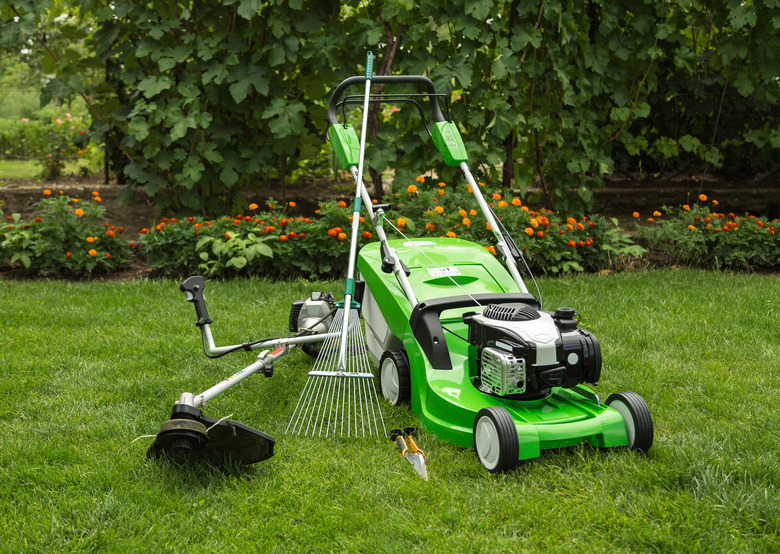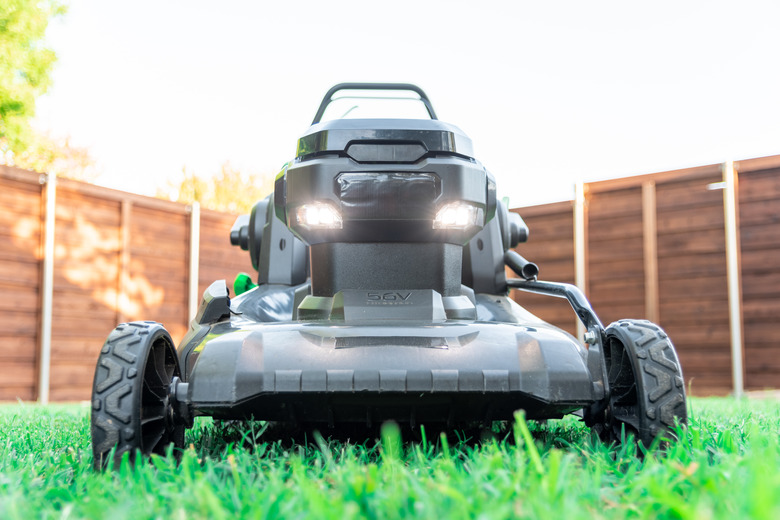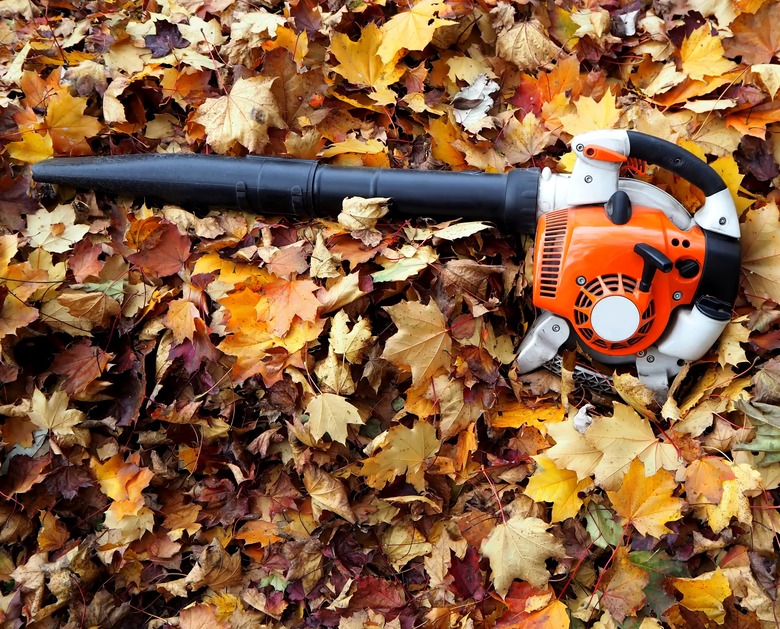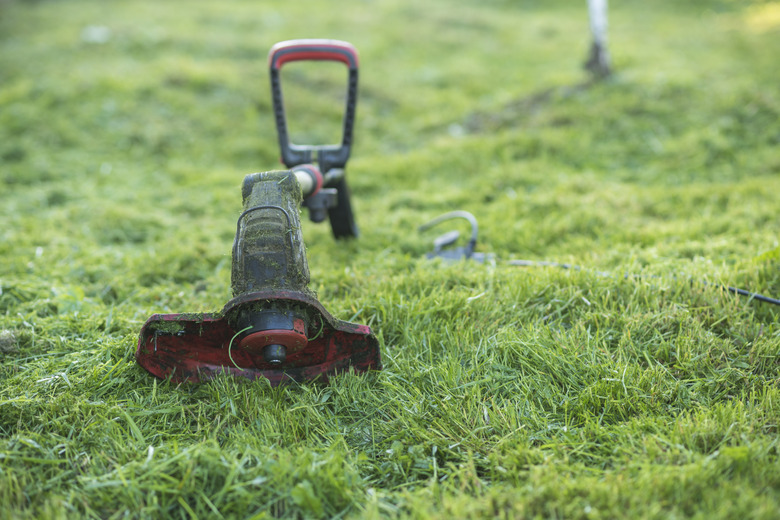A Homeowner's Guide To Lawn Care Tools
We may receive a commission on purchases made from links.
The lawn care required to create and maintain a healthy, thriving lawn involves more than fertilizing and stamping out weeds and busting out the hand tools like pruners. It also requires a group of dedicated garden tools. In addition to a quality lawn mower that does the bulk of the work, consider string trimmers to get to hard-to-reach areas, edgers to give the yard a neat, clean look and leaf blowers to help with cleanup.
Lawn care garden tools come in a variety of sizes, prices and power requirements. Most manufacturers produce old-school gas-powered tools, but you can find the same basic garden tools that run on electricity as well as cordless, or battery-powered, models. There are even cordless riding lawn mowers available.
Be sure to follow the manufacturers' assembly and use instructions and safety precautions. Dress appropriately by wearing shoes, long pants and eye protection when operating lawn care tools. Some tools, such as leaf blowers, require ear protection as well.
Choosing a Lawn Mower
Choosing a Lawn Mower
Most people pick a lawn mower type based on the size of their lawn. Reel mowers are ideal for very small yards and are one of the most environmentally friend garden tools. They have horizontally mounted blades that spin as you mow. You provide the pushing power, so there is no gas to buy or battery to keep charged. They are very quiet, and most allow you to adjust the height of the blades.
Walk-behind gas-power mowers are the most popular lawn care garden tools, however. They are good choices when you have to mow a lawn that is up to about 1/2 acre in size. They fall into two broad categories: push mowers and self-propelled lawn mowers.
As the name implies, self-propelled mowers have motors and transmissions that power the tool. You simply walk behind and steer. Most have multiple speeds that you control at the handle. They can help make short work of larger yards or those with a lot of hills.
Both versions are available in mulching and bagging versions. Mulching mowers cut and recut the grass blades into small pieces that you can leave on the lawn to break down and nourish the grass. Bagging mowers can be either side or rear discharge. Some mowers have both mulching and bagging capabilities (saving you major clean up at the end of the mowing job).
The average cutting width on a power mower is 21 or 22 inches, but you can find wide-cut mowers with up to 33-inch cutting decks. Most mowers allow you to adjust the height of the cutting deck so that you can cut the right amount off the blades.
The engines on gas mowers range from about 120 to 190 cc, which stands for cubic centimeters, a measure of the amount of fuel and air the cylinders push through the engine. The higher the number, the more power and the less likely the engine is to stall when cutting very tall grass.
A basic gas lawn mower can cost under $150. Larger models with sophisticated engines and cutting techniques and other features, such as push-button electric start, can drive the price up to $700 and more.
Corded and Cordless Lawn Mowers
Corded and Cordless Lawn Mowers
It's a simple enough difference: corded mowers plug into an electrical outlet, while cordless mowers run on battery power, but they both have distinct pros and cons in comparison to each other and to other types of lawn mowers. They tend to be smaller and less powerful than gas mowers, but that is changing quickly because manufacturers are developing more powerful lawn care garden tools, especially in the cordless category.
Both corded and cordless lawn mowers start automatically and are low maintenance because there is no oil to change. Many people like them because there are no emissions when the mower is running, making them a more eco-conscious choice for homeowners. The drawback with corded garden tools, however, is that you need a cord that is long enough to cover the entire lawn. You also have to be mindful of where it is while mowing.
A cordless mower is not without its problems either — and nothing is more frustrating than running out of power when you're in the middle of mowing the lawn. To avoid this, choose cordless mowers that have enough run time to let you mow the entire lawn. Batteries range from 20 volts up to about 80 volts. Some high-voltage models are self-propelled.
A corded mower costs about $150 to $200. A cordless model will land in the $200 to $600 range.
Riding Lawn Mowers
Riding Lawn Mowers
There are three broad categories of riding lawn mowers: lawn tractors, rear-engine mowers and zero-turn lawn mowers. Lawn tractors look like, well, small tractors. They are the most powerful of the riding lawn mowers, and many have accessories that are towed behind the tractor, such as carts, leaf vacuums and seed spreaders.
Rear-engine riding lawn mowers look a little like golf carts. Compared with tractors, they are lighter and not as powerful, although there are exceptions. Many homeowners find them a good compromise for lawn care that is too much for a walk-behind mower but not large enough for a tractor.
Zero-turn, or zero-radius, mowers are the mowers you often see used by professional landscapers. These tools have the ability to pivot 180 degrees. So, at the end of a row, the tool can be made to change direction without going through a K-turn or three-point turn to start the next row.
Riding lawn mowers have 30- to 60-inch cutting widths, so they cut a lot of grass quickly. The majority of riding lawn mowers are gas powered, although battery-operated models are available. Expect to pay $1,200 to $7,000 for a riding lawn mower.
String Trimmer Basics
String Trimmer Basics
String trimmers can reach the parts of your lawn that the lawn mower can't reach, such as the strip of grass along a fence or a wall or the edge of a flower bed. They can also help neaten areas along paved surfaces, such as driveways and sidewalks, and they can cut through the tall grass in a neglected area of the yard that might choke a lawn mower.
A string trimmer, also known as a weed whacker, is a handheld cutting tool. A motor spins a microfilament string-like material at high speeds. The line is matched to specific tools and comes in different sizes, from 0.065 inches in diameter for light-duty cutting to 0.110 for heavier work that involves removing woody brush. Most newer models feed line from a spool automatically when the line is worn down. The alternative is bump feed, where you tap the head against the ground to release more line.
As with many other lawn care garden tools, string trimmers are available in gas-powered, corded electric and cordless models. In general, gas engines provide the most power, but all types do a good job of cutting through grass and weeds.
Choosing a String Trimmer
Choosing a String Trimmer
Most professionals prefer gas-powered trimmers because they can work for a long time without stopping. Most string trimmers that run on gas have two-cycle, or two-stroke, engines. It is a simple engine configuration that is lighter than other types. With a two-cycle engine, oil is added to the gas reservoir rather than adding it to a separate lubrication system.
Corded and cordless models start instantly and are quieter than gas trimmers. Cordless batteries are available in a number of sizes from about 20 volts to about 80 volts. Run time varies, but you should get 30 to 45 minutes per charge. Most homeowners have two batteries so that one can be charging while the other is in use.
String trimmers come with either a straight or curved shaft. It pays to handle the tool before buying so that you can determine the one with which you are most comfortable. String trimmers range in price from $100 to $400.
Once the tool is started, you simply place the cutting head where you want it. There's a shield that covers the cutting line, but the tool can still kick up small stones and other debris. Wear shoes when operating a string trimmer and follow other safety practices recommended by the manufacturer.
Leaf Blower Basics
Leaf Blower Basics
Leaf blowers not only move the leaves scattered over your yard into neat piles for pickup but they can also remove grass clippings from paved surfaces, spruce up a patio or deck that is covered with debris and remove a light dusting of snow from sidewalks. Some models convert to vacuum mode to collect the leaves once they are in a pile.
The power a leaf blower produces is measured in two ways: CFM, or the volume of air produced measured in cubic feet per minute, and MPH, or the air's speed as it exits the tip of the tool. High CFM matched with a high MPH produces the most power.
Selection based on power can be tricky. Some manufacturers produce tools with high CFM ratings at the expense of lower MPH ratings. There are handheld gas, corded and cordless models. Often, corded and cordless models are just as powerful as gas-powered leaf blowers. That's because the gas engines are smaller to keep the weight down.
There are also gas-powered and battery-powered backpack-style leaf blowers. These are professional-quality tools that tend to have the highest CFM ratings. There are also walk-behind leaf blowers that are used by many professional landscapers.
Choosing a Leaf Blower
Choosing a Leaf Blower
Leaf blowers make short work of a yard full of leaves compared to old-fashioned raking, but they are noisy, especially the gas-powered models. They can be so loud that some municipalities restrict their use to certain times of day. Some towns have banned them altogether.
Some backpack models can be as loud as 90 decibels (dB). A typical conversation is about 60 dB. A motorcycle engine is about 95 dB. If noise is an issue, look for a tool that produces about 60 dB.
As with string trimmers, corded leaf blowers are confined to the length of the extension cord, and cordless tools depend on the run time of the battery. A leaf blower should last 30 to 60 minutes on a charge.
In addition to the noise, leaf blowers can kick up a lot of dust when working over bare ground. Keep those things in mind when you are doing yard work around your neighbors.
There are leaf blowers for under $100, but good-quality handheld tools are available for $150 to $300. Pro-quality backpack models can cost $600.
Lawn Edger Basics
Lawn Edger Basics
Lawn edgers create a crisp, clean appearance for your lawn because they provide a definite break between the grass and the adjoining paved surface. Edgers can also be used to create separation between the lawn and plantings, such as trees and bushes surrounded with mulch and flower beds. Power edgers can double as trenching tools for installing wiring for low-voltage lighting systems.
As with lawn mowers, small jobs can be handled by manual edgers. These have cutting wheels or disks mounted vertically at the end of a shaft that cuts into the turf as you push the tool along. The more popular alternatives are power edgers, which can be gas-powered, corded electric or cordless models. Many edgers have two rear wheels and a small front wheel to keep the tool balanced, but there are also two-wheel and four-wheel models available.
There are dedicated edger tools as well as multitools that can be converted to string trimmers. These tools have changeable heads to do different jobs.
Using an Edger
Using an Edger
Most edgers for homeowners have a single blade. Good tools let you adjust the cutting depth of the blade, usually up to about 2.5 to 3 inches. The typical blade is a flat, rectangular blade that is fine for normal lawn to pavement edging, but there are other types available. A blade with scoop-cut edges is good for areas that require more finesse, such as around flower beds.
Follow the manufacturer's directions for using the edger, but basically, once you have the tool started, you lower the blade into the ground. The blade on a power edger will pull you along, so let the tool do the work for you. You can edge before or after mowing, but if you edge first, the lawn mower can help blow away some of the debris left on the pavement, and there will be clippings and dirt that must be cleaned up.
Manual and many electric edgers cost under $100. Gas-powered and cordless models cost $100 to $300.



